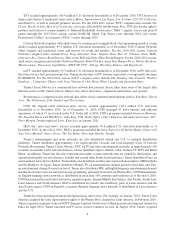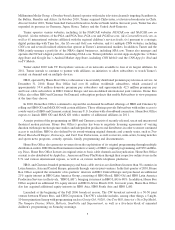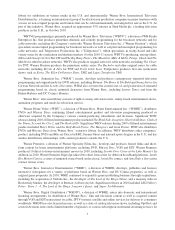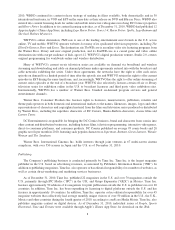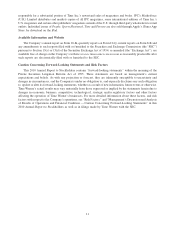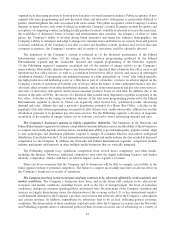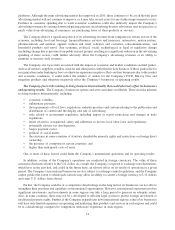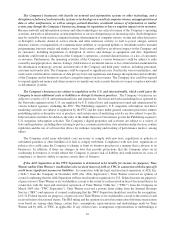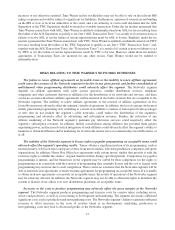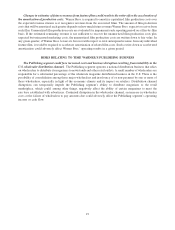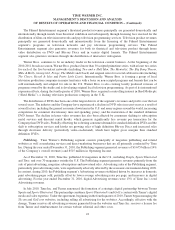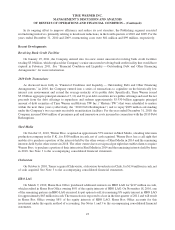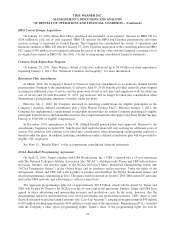Time Magazine 2010 Annual Report Download - page 26
Download and view the complete annual report
Please find page 26 of the 2010 Time Magazine annual report below. You can navigate through the pages in the report by either clicking on the pages listed below, or by using the keyword search tool below to find specific information within the annual report.platforms. Although the print advertising market has improved in 2010, there continues to be a risk that the print
advertising market will not continue to improve, or it may take several years for any further improvement to occur.
Declines in consumer spending due to weak economic conditions could also indirectly impact the Company’s
advertising revenues by causing downward pricing pressure on advertising because advertisers may not perceive as
much value from advertising if consumers are purchasing fewer of their products or services.
The Company derives a significant portion of its advertising revenues from companies in certain sectors of the
economy, including food and beverage, financial/business services and insurance, automotive, motion picture,
pharmaceuticals and medical, apparel, fashion and retail, toiletries and cosmetics, telecommunications, and
household products and travel. Any economic, political, social, technological or legal or regulatory change
(including change due to pressure from public interest groups) resulting in a significant reduction in the advertising
spending of these sectors could further adversely affect the Company’s advertising revenues or its ability to
maintain or increase such revenues.
The Company also faces risks associated with the impact of economic and market conditions on third parties,
such as advertisers, suppliers, retailers, insurers and other parties with which it does business. If these parties file for
reorganization under bankruptcy laws or otherwise experience negative effects on their businesses due to the market
and economic conditions, it could reduce the number of outlets for the Company’s DVD, Blu-ray Disc and
magazine products and otherwise negatively affect the Company’s businesses or operating results.
The Company faces risks relating to doing business internationally that could adversely affect its businesses
and operating results. The Company’s businesses operate and serve customers worldwide. There are risks inherent
in doing business internationally, including:
• economic volatility;
• inflationary pressures;
• the requirements of local laws, regulations, industry practices and customs relating to the publication and
distribution of content and the display and sale of advertising;
• risks related to government regulation, including import or export restrictions and changes in trade
regulations;
• issues related to occupational safety and adherence to diverse local labor laws and regulations;
• potentially adverse tax developments;
• longer payment cycles;
• political or social unrest;
• the existence in some countries of statutory shareholder minority rights and restrictions on foreign direct
ownership;
• the presence of corruption in certain countries; and
• higher than anticipated costs of entry.
One or more of these factors could harm the Company’s international operations and its operating results.
In addition, certain of the Company’s operations are conducted in foreign currencies. The value of these
currencies fluctuates relative to the U.S. dollar. As a result, the Company is exposed to exchange rate fluctuations,
which have in the past had, and could in the future have, an adverse effect on its results of operations in a given
period. The Company’s international businesses are also subject to exchange control regulations, and the Company
cannot predict the extent to which such controls may affect its ability to convert a foreign currency to U.S. dollars
and remit U.S. dollars from abroad.
Further, the Company could be at a competitive disadvantage in the long term if its businesses are not able to
strengthen their positions and capitalize on international opportunities. However, international expansion involves
significant investments, and investments in some regions can take a long period to generate an adequate return.
Also, in some countries, there may not be a developed or efficient legal system to protect foreign investment or
intellectual property rights. Further, if the Company expands into new international regions, some of its businesses
will have only limited experience in operating and marketing their products and services in such regions and could
be at a disadvantage compared to competitors with more experience in such regions.
14


